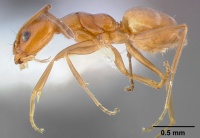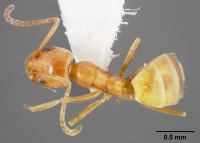Forelius pruinosus
| Forelius pruinosus | |
|---|---|

| |
| Scientific classification | |
| Kingdom: | Animalia |
| Phylum: | Arthropoda |
| Class: | Insecta |
| Order: | Hymenoptera |
| Family: | Formicidae |
| Subfamily: | Dolichoderinae |
| Tribe: | Leptomyrmecini |
| Genus: | Forelius |
| Species: | F. pruinosus |
| Binomial name | |
| Forelius pruinosus (Roger, 1863) | |
| Synonyms | |
| |
| Common Name | |
|---|---|
| High Noon Ant | |
| Language: | English |
Colonies typically inhabit large polygnynous ground nests. Disorganized small soil craters may also be found at the entrance to some uncovered ground nest entrances. Their predilection for open habitats leads to Forelius pruinosus being a common ant in many anthropogenic and disturbed habitats.
| At a Glance | • Polygynous |
Identification
Similar in form to Tapinoma but the small petiole, partially hidden by the gaster, is larger in comparison to the almost nonexistent petiolar node of Tapinoma.
Forelius from the western United States and northern Mexico are part of a species complex that is in need of taxonomic revision. The form we currently assign to Forelius pruinosus, at least in the southwest, likely includes pruinosus and one or more undescribed species. This species group can be distinguished from Forelius mccooki by a lack of standing hairs on the scape.
Ward (2005) provides his evaluation of the western North American Forelius species: After examining a large series of Forelius from the United States and northern Mexico I can find no consistent difference in worker head shape: the posterior margin of the head varies continuously from weakly convex through straight to weakly concave. Color is also variable, ranging from dark brown to yellowish-orange. Some nest series contain both light and dark-colored workers. It is possible that the California populations are not conspecific with F. pruinosus (described from Cuba), but these and other western samples seem to grade insensibly into material from farther east and south, including populations in Florida and the West Indies with consistently dark and densely pubescent workers, which correspond to 'F. pruinosus' (s.s.). The complex needs further study but because reliable diagnostic differences have not yet been uncovered I treat F. analis (type locality Chihuahua, Mexico) as a junior synonym of F. pruinosus (syn. nov.).
Identification Keys including this Taxon
Distribution
United States, Mexico, Caribbean and possibly South America. Described from Cuban specimens, the species as currently understood occurs in portions of the northern United States (records exist as far north as Long Island and North Dakota), throughout the southern United States, Cuba, Mexico and possible into South America.
Jack Longino: This species occurs in the most arid portions of Costa Rica. Jenny Jacobs collected it on some of the small islands near the Santa Elena Peninsula, and Phil Ward collected it near Playa Nancite in Santa Rosa National Park.
Latitudinal Distribution Pattern
Latitudinal Range: 47.79° to -19.6°.
| North Temperate |
North Subtropical |
Tropical | South Subtropical |
South Temperate |
- Source: AntMaps
Distribution based on Regional Taxon Lists
Nearctic Region: United States.
Neotropical Region: Cuba (type locality), Mexico.
Distribution based on AntMaps
Distribution based on AntWeb specimens
Check data from AntWeb
Countries Occupied
| Number of countries occupied by this species based on AntWiki Regional Taxon Lists. In general, fewer countries occupied indicates a narrower range, while more countries indicates a more widespread species. |

|
Biology
Forelius pruinosus, senso lato, is an arid, open habitat ant that thrives in hot and dry conditions. Forelius species in the southwestern U.S. are active in the hottest part of the day, foraging and running along trails at temperatures that other co-occurring species cannot tolerate. Foraging does not take place at night, presumably because of cooler temperatures.
Trunk trails are used by foragers with workers searching for food on the ground and on vegetation. Foragers are general scavengers that will tend aphids and feed from plant nectaries.
M.R. Smith (1965), reporting on eastern U.S. ant pests, provides this description of their biology: The ants seem to prefer open habitats such as fields, meadows, pastures, and entirely bare areas, and will also nest in open woods out of dense and prolonged shade. Nests are constructed in exposed soil or soil under the cover of stones, other objects, and under the bark of logs and stumps. Entrance holes of nests in the soil commonly have crater-shaped mounds of earth surrounding them, but the craters may be imperfectly shaped, or the ground may be more or less bare. Colonies are small to moderate-sized. Males and winged females have been observed in Florida from May into July. Workers are very fond of honeydew, and tend honeydew-excreting insects; they also live on both live and dead insects. The very agile, fast-moving workers form pronounced foraging trails. M. S. Blum, in a letter to the author, wrote that the ants lay down on their foraging trails a methyl-n-amyl ketone substance, which is emitted from the gaster. Workers have been induced to follow artificial trails on which this synthetic chemical has been placed. The odor emitted by live or freshly killed workers has been likened to that of rotton coconuts and is similar to the odor of ants of the genus Tapinoma.
This species is a house pest particularly in the Gulf Coast States. Most frequently the ants invade houses from outdoors, but it is quite likely that they may nest within houses as well. Although workers feed on most of the foods commonly eaten by ants, they seem to show a preference for sweets.
Some of this account is curious, as the species is not known to be much of a house pest today. The reported nesting locations under wood or stones is also interesting. Most of the forms of this ant do not prefer such microsites.
Roeder et al. (2018) in an Oklahoma study found the CTmax (critical thermal maximum) for this species was 56.0 ± 0.3 C and the average worker mass was 0.099 ± 0.004 mg.
Forelius pruinosus is known to remove seeds (Atchison & Lucky, 2022; Stamp & Lucas, 1990; Stuble et al., 2010).
Regional Notes
New Mexico
Mackay and Mackay (2002) - Habitat Widely distributed in many habitats in New Mexico. Most common in arid habitats (desert scrub, including open weedy areas, grama grasslands, fluff grass areas, creosote scrub, mesquite woodlands), although also occurs in Juniper, sagebrush, riparian and even into pine forests. Biology This ant usually nests in the soil, in open areas, but may be found nesting under stones. The nest usually consists of a small mound (diameter of few cms) with the entrance hole in the center. Reproductives were found in nests from May to August. Multiple queens are present in nests. The habits are very similar to those of Forelius mccooki. Food consists of living and dead insects; this species also tends Homoptera and feeds on flower nectar. It can be a serious house pest.
Association with Other Organisms
 Explore: Show all Associate data or Search these data. See also a list of all data tables or learn how data is managed.
Explore: Show all Associate data or Search these data. See also a list of all data tables or learn how data is managed.
- This species is a host for the Microdon fly Microdon fuscipennis (a predator) in Georgia (Macquart, 1834).
- This species is a host for the cestode Raillietina tetragona (a parasitoid) (Quevillon, 2018) (encounter mode secondary; indirect transmission; transmission outside nest).
Flight Period
| X | X | X | X | ||||||||
| Jan | Feb | Mar | Apr | May | Jun | Jul | Aug | Sep | Oct | Nov | Dec |
Source: antkeeping.info.
- Check details at Worldwide Ant Nuptial Flights Data, AntNupTracker and AntKeeping.
 Explore: Show all Flight Month data or Search these data. See also a list of all data tables or learn how data is managed.
Explore: Show all Flight Month data or Search these data. See also a list of all data tables or learn how data is managed.
Life History Traits
- Queen number: monogynous (Rissing and Pollock, 1988; Frumhoff & Ward, 1992)
Castes
Worker
  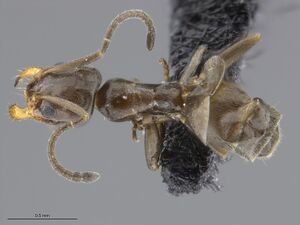 
| |
| Worker. . | Owned by Museum of Comparative Zoology. |
Images from AntWeb
   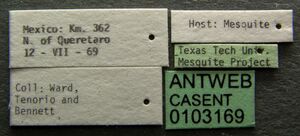
| |
| Worker. Specimen code casent0103169. Photographer April Nobile, uploaded by California Academy of Sciences. | Owned by USNM, Washington, DC, USA. |
 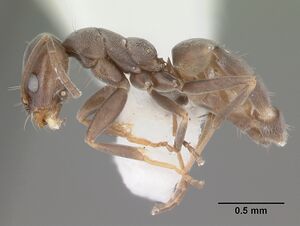  
| |
| Worker. Specimen code casent0103912. Photographer April Nobile, uploaded by California Academy of Sciences. | Owned by ABS, Lake Placid, FL, USA. |
   
| |
| Worker. Specimen code casent0196149. Photographer Erin Prado, uploaded by California Academy of Sciences. | Owned by CAS, San Francisco, CA, USA. |
  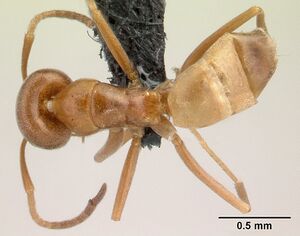 
| |
| Worker. Specimen code casent0196151. Photographer Erin Prado, uploaded by California Academy of Sciences. | Owned by CAS, San Francisco, CA, USA. |
   
| |
| Worker. Specimen code psw14182-1. Photographer April Nobile, uploaded by California Academy of Sciences. | Owned by UCDC, Davis, CA, USA. |
Queen
Images from AntWeb
 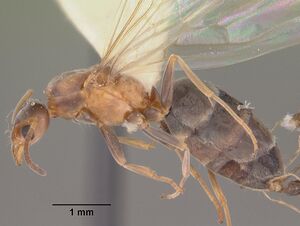 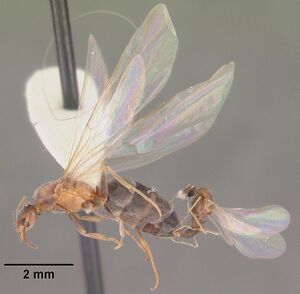 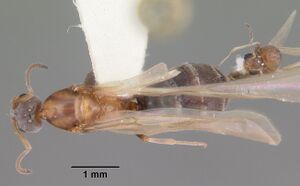 
| |
| Queen (alate/dealate). Specimen code casent0103908. Photographer April Nobile, uploaded by California Academy of Sciences. | Owned by ABS, Lake Placid, FL, USA. |
Male
Images from AntWeb
   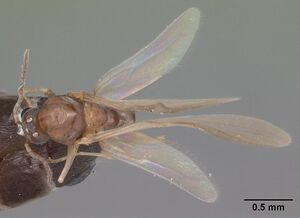 
| |
| Male (alate). Specimen code casent0102698. Photographer April Nobile, uploaded by California Academy of Sciences. | Owned by ABS, Lake Placid, FL, USA. |
Nomenclature
The following information is derived from Barry Bolton's Online Catalogue of the Ants of the World.
- pruinosus. Tapinoma pruinosum Roger, 1863a: 165 (w.) CUBA. Wheeler, G.C. & Wheeler, J. 1951: 185 (l.). Combination in Iridomyrmex: Wheeler, W.M. 1913b: 497; in Forelius: Wheeler, G.C. & Wheeler, J. 1986g: 13; Shattuck, 1992c: 95. Senior synonym of testaceus: Cuezzo, 2000: 261; of analis: Ward, 2005: 9. See also: Creighton, 1950a: 342; Petralia & Vinson, 1980: 386; Guerrero & Fernández, 2008: 57.
- analis. Tapinoma anale André, 1893b: 148 (w.) MEXICO. Combination in Iridomyrmex: Forel, 1908b: 62; in Forelius: Wheeler, G.C. & Wheeler, J. 1986g: 13. Subspecies of pruinosus: Emery, 1895c: 333; Wheeler, W.M. 1913b: 497; Creighton, 1950a: 343; Shattuck, 1994: 96. Junior synonym of pruinosus: Wheeler, G.C. & Wheeler, J. 1986g: 13; Bolton, 1995b: 190. Status as species: Forel, 1908b: 62; Emery, 1913a: 26; Cuezzo, 2000: 222. Junior synonym of pruinosus: Ward, 2005: 9.
- testaceus. Iridomyrmex pruinosus var. testaceus Cole, 1936b: 121 (w.q.) U.S.A. Junior synonym of analis: Creighton, 1950a: 343; of pruinosus: Cuezzo, 2000: 261.
Description
Etymology
Descriptive. pruinosus translates to "covered with hoarfrost" and this presumably describes the dense pubescence that covers the workers
Worker Morphology
 Explore: Show all Worker Morphology data or Search these data. See also a list of all data tables or learn how data is managed.
Explore: Show all Worker Morphology data or Search these data. See also a list of all data tables or learn how data is managed.
- Caste: monomorphic
References
- Alatorre-Bracamontes, C.E., Vásquez-Bolaños, M. 2010. Lista comentada de las hormigas (Hymenoptera: Formicidae) del norte de México. Dugesiana 17(1): 9-36.
- André, E. 1893b. Description de quatre espèces nouvelles de fourmis d'Amérique. Rev. Entomol. (Caen) 12: 148-152.
- Atchison, R. A., Lucky, A. 2022. Diversity and resilience of seed-removing ant species in Longleaf Sandhill to frequent fire. Diversity 14, 1012 (doi:10.3390/d14121012).
- Berkelhamer, R.C. 1980. Reproductive strategies in ants: A comparison of single-queened versus multiple-queened species in the subfamily Dolichoderinae (Hymenoptera: Formicidae). Ph.D. thesis, University of California, Berkeley.
- Carroll, T.M. 2011. The ants of Indiana (Hymenoptera: Formicidae). M.S. thesis, Purdue University.
- Creighton, W. S. 1950a. The ants of North America. Bulletin of the Museum of Comparative Zoology 104: 1-585 (page 342, see also)
- Cuezzo, F. 2000. Revisión del género Forelius (Hymenoptera: Formicidae: Dolichoderinae). Sociobiology 35: 197-275 (page 261, Senior synonym of testaceus)
- Davis, T. 2009. The ants of South Carolina (thesis, Clemson University).
- Deyrup, M.A., Carlin, N., Trager, J., Umphrey, G. 1988. A review of the ants of the Florida Keys. Florida Entomologist 71: 163-176.
- Fontenla, J.L., Brito, Y.M. 2011. Hormigas invasoras y vagabundas de Cuba. Fitosanidad 15(4), 253-259.
- Godfrey, R.K., Oberski, J.T., Allmark, T., Givens, C., Hernandez-Rivera, J., Gronenberg, W. 2021. Olfactory system morphology suggests colony size drives trait evolution in Odorous Ants (Formicidae: Dolichoderinae). Frontiers in Ecology and Evolution 9, 733023 (doi:10.3389/fevo.2021.733023).
- Guerrero, R.J. 2021. Transfer of two South American ant species from Tapinoma Foerster 1850 to Forelius Emery 1888 (Hymenoptera: Formicidae: Dolichoderinae). Zootaxa 4920, 428–438 (doi:10.11646/zootaxa.4920.3.8).
- Hoey-Chamberlain, R., Rust, M.K., Klotz, J.H. 2013. A review of the biology, ecology and behavior of Velvety Tree Ants of North America. Sociobiology 60(1): 1-10.
- Hoey-Chamberlain, R.V. 2012. Food preference, survivorship, and intraspecific interactions of Velvety Tree Ants. M.S. thesis, University of California, Riverside.
- Ipser, R.M., Brinkman, M.A., Gardner, W.A., Peeler, H.B. 2004. A survey of ground-dwelling ants (Hymenoptera: Formicidae) in Georgia. Florida Entomologist 87: 253-260.
- Ivanov, K. 2019. The ants of Ohio (Hymenoptera, Formicidae): an updated checklist. Journal of Hymenoptera Research 70: 65–87 (doi:10.3897@jhr.70.35207).
- MacGown, J.A., Booher, D., Richter, H., Wetterer, J.K., Hill, J.G. 2021. An updated list of ants of Alabama (Hymenoptera: Formicidae) with new state records. Transactions of the American Entomological Society 147: 961-981 (doi:10.3157/061.147.0409).
- Mackay, W. P. and E. Mackay. 2002. The ants of New Mexico (Hymenoptera: Formicidae). Edwin Mellen Press, Lewiston, NY.
- Moura, M.N., Cardoso, D.C., Cristiano, M.P. 2020. The tight genome size of ants: diversity and evolution under ancestral state reconstruction and base composition. Zoological Journal of the Linnean Society, zlaa135 (doi:10.1093/zoolinnean/zlaa135).
- Oberski, J.T. 2022. First phylogenomic assessment of the amphitropical New World ant genus Dorymyrmex (Hymenoptera: Formicidae), a longstanding taxonomic puzzle. Insect Systematics and Diversity 6(1): 8; 1–10 (doi:10.1093/isd/ixab022).
- Oberski, J.T. 2024. Ultraconserved element (UCE) phylogenomics illuminates the evolutionary history and biogeography of Dorymyrmex pyramid ants. Systematic Entomology, 1-24 (doi:10.1111/syen.12658).
- Petralia, R. S.; Vinson, S. B. 1980 [1979]. Comparative anatomy of the ventral region of ant larvae, and its relation to feeding behavior. Psyche (Camb.) 86: 375-394 (page 386, see also)
- Roeder, K. A., D. V. Roeder, and M. Kaspari. 2018. The role of temperature in competition and persistence of an invaded ant assemblage. Ecological Entomology. 43:774-781. doi:10.1111/een.12663
- Roger, J. 1863a. Die neu aufgeführten Gattungen und Arten meines Formiciden-Verzeichnisses nebst Ergänzung einiger früher gegebenen Beschreibungen. Berl. Entomol. Z. 7: 131-214 (page 165, worker described)
- Shattuck, S. O. 1992c. Generic revision of the ant subfamily Dolichoderinae (Hymenoptera: Formicidae). Sociobiology 21: 1-181 (page 95, Combination in Forelius)
- Smith, M. R. 1965. House-infesting ants of the eastern United States. Their recognition, biology, and economic importance. United States Department of Agriculture, Technical Bulletin 1326
- Stamp, N.E., Lucas, J.R. 1990. Spatial patterns and dispersal distances of explosively dispersing plants in Florida sandhill vegetation. Journal of Ecology 78, 589–600.
- Stuble, K.L., Kirkman, L.K., Carroll, C.R. 2010. Are red imported fire ants facilitators of native seed dispersal? Biological Invasions 12, 1661–1669.
- Uhey, D.A., Riskas, H.L., Smith, A.D., Hofstetter, R.W. 2020. Ground-dwelling arthropods of pinyon-juniper woodlands: Arthropod community patterns are driven by climate and overall plant productivity, not host tree species. PLOS ONE 15, e0238219. (doi:10.1371/journal.pone.0238219).
- Varela-Hernández, F., Medel-Zosayas, B., Martínez-Luque, E.O., Jones, R.W., De la Mora, A. 2020. Biodiversity in central Mexico: Assessment of ants in a convergent region. Southwestern Entomologist 454: 673-686.
- Varela-Hernández, F., Riquelme, F., Guerrero, R. 2023. A Miocene ant species of the genus Forelius Emery, 1888 (Hymenoptera: Formicidae: Dolichoderinae) from Mexico. Palaeontologia Electronica 26(3):a36 (doi:10.26879/1294).
- Ward, P.S. 2005. A synoptic review of the ants of California (Hymenoptera: Formicidae). Zootaxa 936: 1-68 (page 9, Senior synonym of analis)
- Wheeler, G. C.; Wheeler, J. 1951. The ant larvae of the subfamily Dolichoderinae. Proc. Entomol. Soc. Wash. 53: 169-210 (page 185, larva described)
- Wheeler, G. C.; Wheeler, J. 1986g. The ants of Nevada. Los Angeles: Natural History Museum of Los Angeles County, vii + 138 pp. (page 13, Combination in Forelius)
- Wheeler, W. M. 1913b. The ants of Cuba. Bulletin of the Museum of Comparative Zoology 54: 477-505 (page 497, Combination in Iridomyrmex)
References based on Global Ant Biodiversity Informatics
- Addison D. S., I. Bartoszek, V. Booher, M. A. Deyrup, M. Schuman, J. Schmid, and K. Worley. 2016. Baseline surveys for ants (Hymenoptera: Formicidae) of the western Everglades, Collier County, Florida. Florida Entomologist 99(3): 389-394.
- Alayo D. P. 1974. Introduccion al estudio de los Himenopteros de Cuba. Superfamilia Formicoidea. Academia de Ciencias de Cuba. Instituto de Zoologia. Serie Biologica no.53: 58 pp. La Habana.
- Allred D. M. 1982. Ants of Utah. The Great Basin Naturalist 42: 415-511.
- Allred D. M., and A. C. Cole, Jr. 1971. Ants of the National Reactor Testing Station. Great Basin Naturalist 31: 237-242.
- Allred, D.M. 1982. The ants of Utah. Great Basin Naturalist 42:415-511.
- Annotated Ant Species List Ordway-Swisher Biological Station. Downloaded at http://ordway-swisher.ufl.edu/species/os-hymenoptera.htm on 5th Oct 2010.
- Beck D. E., D. M. Allred, W. J. Despain. 1967. Predaceous-scavenger ants in Utah. Great Basin Naturalist 27: 67-78
- Beckmann R. L., and J. M. Stucky. 1981. Extrafloral Nectaries and Plant Guarding in Ipomoea pandurata (L.) G. F. W. Mey. (Convolvulaceae). American Journal of Botany 68(1): 72-79.
- Bestelmeyer B. T., and J. A. Wiens. 2001. Local and regional-scale responses of ant diversity to a semiarid biome transition. Ecography 24: 381-392.
- Boulton A.M. and P.S. Ward. 2002. Ants. Chapter 5 in A New island Biogeography of the Sea of Cortes. T.J. Case, M.L. Cody and E. Ezcurra. Oxford university Press.
- Braman C. A., and B. T. Forschler. 2018. Survey of Formicidae attracted to protein baits on Georgia’s Barrier Island dunes. Southeastern Naturalist 17(4): 645-653.
- Branstetter M. G. and L. Sáenz. 2012. Las hormigas (Hymenoptera: Formicidae) de Guatemala. Pp. 221-268 in: Cano E. B. and J. C. Schuster. (eds.) 2012. Biodiversidad de Guatemala. Volumen 2. Guatemala: Universidad del Valle de Guatemala, iv + 328 pp
- Callcott A. M. A., D. H. oi, H. L. Collins, D. F. Williams, and T. C. Lockley. 2000. Seasonal Studies of an Isolated Red Imported Fire Ant (Hymenoptera: Formicidae) Population in Eastern Tennessee. Environmental Entomology, 29(4): 788-794.
- Campbell J. W., S. M. Grodsky, D. A. Halbritter, P. A. Vigueira, C. C. Vigueira, O. Keller, and C. H. Greenberg. 2019. Asian needle ant (Brachyponera chinensis) and woodland ant responses to repeated applications of fuel reduction methods. Ecosphere 10(1): e02547.
- Campbell K. U., and T. O. Crist. 2017. Ant species assembly in constructed grasslands isstructured at patch and landscape levels. Insect Conservation and Diversity doi: 10.1111/icad.12215
- Cancino, E.R., D.R. Kasparan, J.M.A. Coronado Blanco, S.N. Myartseva, V.A. Trjapitzin, S.G. Hernandez Aguilar and J. Garcia Jimenez. 2010. Himenópteros de la Reserva El Cielo, Tamaulipas, México. Dugesiana 17(1):53-71
- Carroll T. M. 2011. The ants of Indiana (Hymenoptera: Formicidae). Master's Thesis Purdue university, 385 pages.
- Castano-Meneses, G., M. Vasquez-Bolanos, J. L. Navarrete-Heredia, G. A. Quiroz-Rocha, and I. Alcala-Martinez. 2015. Avances de Formicidae de Mexico. Universidad Nacional Autonoma de Mexico.
- Clark Adam. Personal communication on November 25th 2013.
- Cokendolpher J. C., and O. F. Francke. 1990. The ants (Hymenoptera, Formicidae) of western Texas. Part II. Subfamilies Ecitoninae, Ponerinae, Pseudomyrmecinae, Dolichoderinae, and Formicinae. Special Publications, the Museum. Texas Tech University 30:1-76.
- Cole A. C. 1940. A Guide to the Ants of the Great Smoky Mountains National Park, Tennessee. American Midland Naturalist 24(1): 1-88.
- Cole A. C., Jr. 1942. The ants of Utah. American Midland Naturalist 28: 358-388.
- Cole, A.C. 1936. An annotated list of the ants of Idaho (Hymenoptera; Formicidae). Canadian Entomologist 68(2):34-39
- Cook J. L. 2003. Conservation of biodiversity in an area impacted by the red imported fire ant, Solenopsis invicta (Hymenoptera: Formicidae). Biodiversity and Conservation 12: 187195.
- Coovert G. A. 2005. The Ants of Ohio (Hymenoptera: Formicidae). Ohio Biological Survey, Inc. 15(2): 1-207.
- Coovert, G.A. 2005. The Ants of Ohio (Hymenoptera: Formicidae) Ohio Biological Survey Bulletin New Series Volume 15(2):1-196
- Cuezzo F. 2000. Revisión del género Forelius (Hymenoptera: Formicidae: Dolichoderinae). Sociobiology 35: 197-275.
- Dash S. T. and L. M. Hooper-Bui. 2008. Species diversity of ants (Hymenoptera: Formicidae) in Louisiana. Conservation Biology and Biodiversity. 101: 1056-1066
- Dattilo W. et al. 2019. MEXICO ANTS: incidence and abundance along the Nearctic-Neotropical interface. Ecology https://doi.org/10.1002/ecy.2944
- Davis W. T., and J. Bequaert. 1922. An annoted list of the ants of Staten Island and Long Island, N. Y. Bulletin of the Brooklyn Entomological Society 17(1): 1-25.
- Dejean, A., S. Durou, I. Olmsted, R.R. Snelling and J. Orivel. 2003. Nest Site Selection by Ants in a Flooded Mexican Mangrove, with Special Reference to the Epiphytic Orchid Myrmecophila christinae. Journal of Tropical Ecology 19(3) :325-331
- Dejean, A., S. Durou, I. Olmsted, R.R. Snelling and J. Orivel. 2003. Nest Site Selection by Ants in a Flooded Mexican Mangrove, with Special Reference to the Epiphytic Orchid Myrmecophila christinae. Journal of Tropical Ecology 19(3):325-331
- Dennis C. A. 1938. The distribution of ant species in Tennessee with reference to ecological factors. Annals of the Entomological Society of America 31: 267-308.
- Des Lauriers J., and D. Ikeda. 2017. The ants (Hymenoptera: Formicidae) of the San Gabriel Mountains of Southern California, USA with an annotated list. In: Reynolds R. E. (Ed.) Desert Studies Symposium. California State University Desert Studies Consortium, 342 pp. Pages 264-277.
- Deyrup M., C. Johnson, G. C. Wheeler, J. Wheeler. 1989. A preliminary list of the ants of Florida. Florida Entomologist 72: 91-101
- Deyrup M., L. Davis, and S. Buckner. 1998. Composition of the ant fauna of three Bahamian islands. Proceedings of the seventh symposium on the natural history of the Bahamas. 23-32. Bahamian Field Station, San Salvador, Bahamas
- Deyrup M., L. Deyrup, and J. Carrel. 2013. Ant Species in the Diet of a Florida Population of Eastern Narrow-Mouthed Toads, Gastrophryne carolinensis. Southeastern Naturalist 12(2): 367-378.
- Deyrup, M. and J. Trager. 1986. Ants of the Archbold Biological Station, Highlands County, Florida (Hymenoptera: Formicidae). Florida Entomologist 69(1):206-228
- Deyrup, Mark A., Carlin, Norman, Trager, James and Umphrey, Gary. 1988. A Review of the Ants of the Florida Keys. The Florida Entomologist. 71(2):163-176.
- Dubois, M.B. and W.E. Laberge. 1988. An Annotated list of the ants of Illionois. pages 133-156 in Advances in Myrmecology, J. Trager
- Eastlake Chew A. and Chew R. M. 1980. Body size as a determinant of small-scale distributions of ants in evergreen woodland southeastern Arizona. Insectes Sociaux 27: 189-202
- Emery C. 1895. Beiträge zur Kenntniss der nordamerikanischen Ameisenfauna. (Schluss). Zoologische Jahrbücher. Abteilung für Systematik, Geographie und Biologie der Tiere 8: 257-360.
- Emery C. 1913. Hymenoptera. Fam. Formicidae. Subfam. Dolichoderinae. Genera Insectorum 137: 1-50.
- Epperson, D.M. and C.R. Allen. 2010. Red Imported Fire Ant Impacts on Upland Arthropods in Southern Mississippi. American Midland Naturalist, 163(1):54-63.
- Fernandes, P.R. XXXX. Los hormigas del suelo en Mexico: Diversidad, distribucion e importancia (Hymenoptera: Formicidae).
- Flores-Maldonado K. Y., S. A. Phillips, and G. Sanchez-Ramos. 1999. The myrmecofauna (Hymenoptera: Formicidae) along an altitudinal gradient in the Sierra Madre Oriental of Northeastern Mexico. The Southwestern Naturalist 44(4): 457-461.
- Flores-Maldonado, K. Y., S. A. Phillips-Jr, and G. Sanchez-Ramos. 1999. The myrmecofauna (Hymenoptera: Formicidae) along an altitudinal gradient in the Sierra Madre Oriental of Northeastern Mexico. The Southwestern Naturalist 44: 457-461.
- Fontanla Rizo J.L. 1997. Lista preliminar de las hormigas de Cuba. Cocuyo 6: 18-21.
- Fontenla J. L. 2005. Species of ants (Formicidae) recorded in the Sierra de Cubitas and adjacent areas, Camagüey Province, 16-19 September 2002. In: Díaz, L., M., W. S. Alverson, A. Barreto V., y / and T. Wachter. 2006. Cuba: Camagüey, Sierra de Cubitas. Rapid Biological Inventories Report 08. The Field Museum, Chicago
- Fontenla J. L., and J. Alfonso-Simonetti. 2018. Classification of Cuban ants (Hymenoptera: Formicidae) into functional groups. Poeyana Revista Cubana de Zoologia 506: 21-30.
- Fontenla Rizo J. L. 1993. Composición y estructura de comunidades de hormigas en un sistema de formaciones vegetales costeras. Poeyana. Instituto de Ecología y Sistemática, Academia de Ciencias de Cuba 441: 1-19.
- Fontenla Rizo J. L. 1993. Mirmecofauna de Isla de la Juventud y de algunos cayos del archipielago cubano. Poeyana. Instituto de Ecologia y Sistematica, Academia de Ciencias de Cuba 444:1-7.
- Fontenla Rizo J. L. 1997. Lista preliminar de las hormigas de Cuba (Hymenoptera: Formicidae). Cocuyo 6: 18-21.
- Frye J. A., T. Frye, and T. W. Suman. 2014. The ant fauna of inland sand dune communities in Worcester County, Maryland. Northeastern Naturalist, 21(3): 446-471.
- Gallardo A. 1916. Las hormigas de la República Argentina. Subfamilia Dolicoderinas. Anales del Museo Nacional de Historia Natural de Buenos Aires 28: 1-130.
- Gans M. J., J. R. Arnold, A. Cohuo, L. Castro, D. Lam, and C. Wiley. 2016. Survey of ant species in Rockwall County, Texas. Southwestern Entomologist 41(2): 373-378.
- General D. M., and L. C. Thompson. 2011. New Distributional Records of Ants in Arkansas for 2009 and 2010 with Comments on Previous Records. Journal of the Arkansas Academy of Science 65: 166-168.
- General D., and L. Thompson. 2008. Ants of Arkansas Post National Memorial: How and Where Collected. Journal of the Arkansas Academy of Science 62: 52-60.
- General D.M. & Thompson L.C. 2007. Ants (Hymenoptera: Formicidae) of Arkansas Post National Memorial. Journal of the Arkansas Acaedemy of Science. 61: 59-64
- General D.M. & Thompson L.C. 2008. New Distributional Records of Ants in Arkansas for 2008. Journal of the Arkansas Academy of Science. 63: 182-184
- Gonzales-Valvidia N. A., G. Gonzales-Escolastico, E. Barba, S. Hernandez-Daumas, and S. Ochoa-Gaona. 2013. Mirmecofauna associated with agroforestry systems in the Mesoamerican Biological Corridor in Tabasco, Mexico. Revista Mexicana de Biodiversidad 84: 306-317.
- Gove, A. D., J. D. Majer, and V. Rico-Gray. 2009. Ant assemblages in isolated trees are more sensitive to species loss and replacement than their woodland counterparts. Basic and Applied Ecology 10: 187-195.
- Graham J.H., H.H. Hughie, S. Jones, K. Wrinn, A.J. Krzysik, J.J. Duda, D.C. Freeman, J.M. Emlen, J.C. Zak, D.A. Kovacic, C. Chamberlin-Graham, H. Balbach. 2004. Habitat disturbance and the diversity and abundance of ants (Formicidae) in the Southeastern Fall-Line Sandhills. 15pp. Journal of Insect Science. 4: 30
- Graham, J.H., A.J. Krzysik, D.A. Kovacic, J.J. Duda, D.C. Freeman, J.M. Emlen, J.C. Zak, W.R. Long, M.P. Wallace, C. Chamberlin-Graham, J.P. Nutter and H.E. Balbach. 2008. Ant Community Composition across a Gradient of Disturbed Military Landscapes at Fort Benning, Georgia. Southeastern Naturalist 7(3):429-448
- Gregg, R.T. 1963. The Ants of Colorado.
- Guerrero R. J., and F. Fernández. 2008. A new species of the ant genus Forelius (Formicidae: Dolichoderinae) from the dry forest of Colombia. Zootaxa. 1958: 51-60.
- Guénard B., K. A. Mccaffrey, A. Lucky, and R. R. Dunn. 2012. Ants of North Carolina: an updated list (Hymenoptera: Formicidae). Zootaxa 3552: 1-36.
- Hess C. G. 1958. The ants of Dallas County, Texas, and their nesting sites; with particular reference to soil texture as an ecological factor. Field and Laboratory 26: 3-72.
- Higgins J. W., N. S. Cobb, S. Sommer, R. J. Delph, and S. L. Brantley. 2014. Ground-dwelling arthropod responses to succession in a pinyon-juniper woodland. Ecosphere 5(1):5. http://dx.doi.org/10.1890/ES13-00270.1
- Hoey-Chamberlain R. V., L. D. Hansen, J. H. Klotz and C. McNeeley. 2010. A survey of the ants of Washington and Surrounding areas in Idaho and Oregon focusing on disturbed sites (Hymenoptera: Formicidae). Sociobiology. 56: 195-207
- Ipser R. M. 2004. Native and exotic ants (Hymenoptera: Formicidae) of Georgia: Ecological Relationships with implications for development of biologically-based management strategies. Doctor of Philosophy thesis, University of Georgia. 165 pages.
- Ipser, R.M., M.A. Brinkman, W.A. Gardner and H.B. Peeler. 2004. A Survey of Ground-Dwelling Ants (Hymenoptera: Formicidae) in Georgia. The Florida Entomologist 87(3) 253-260.
- Ivanov, K. 2019. The ants of Ohio (Hymenoptera, Formicidae): an updated checklist. Journal of Hymenoptera Research 70: 65–87.
- Ivanov K., L. Hightower, S. T. Dash, and J. B. Keiper. 2019. 150 years in the making: first comprehensive list of the ants (Hymenoptera: Formicidae) of Virginia, USA. Zootaxa 4554 (2): 532–560.
- Jacobs J. M., J. T. Longino, and F. J. Joyce. 2011. Ants of the Islas Murciélago: an inventory of the ants on tropical dry forest islands in northwest Costa Rica. Tropical Conservation Science 4(2): 149-171.
- Jeanne R. J. 1979. A latitudinal gradient in rates of ant predation. Ecology 60(6): 1211-1224.
- Johnson C. 1986. A north Florida ant fauna (Hymenoptera: Formicidae). Insecta Mundi 1: 243-246
- Johnson R. Personnal Database. Accessed on February 5th 2014 at http://www.asu.edu/clas/sirgtools/resources.htm
- Johnson, R.A. and P.S. Ward. 2002. Biogeography and endemism of ants (Hymenoptera: Formicidae) in Baja California, Mexico: a first overview. Journal of Biogeography 29:10091026/
- Kempf, W.W. 1972. Catalago abreviado das formigas da regiao Neotropical (Hym. Formicidae) Studia Entomologica 15(1-4).
- Kusnezov N. 1963. Zoogeografia de las hormigas en sudamerica. Acta Zoologica Lilloana 19: 25-186
- La Rivers I. 1968. A first listing of the ants of Nevada. Biological Society of Nevada, Occasional Papers 17: 1-12.
- Lavigne R., and T. J. Tepedino. 1976. Checklist of the insects in Wyoming. I. Hymenoptera. Agric. Exp. Sta., Univ. Wyoming Res. J. 106: 24-26.
- LeBrun E. G., R. M. Plowes, and L. E. Gilbert. 2015. Imported fire ants near the edge of their range: disturbance and moisture determine prevalence and impact of an invasive social insect. Journal of Animal Ecology,81: 884–895.
- Llyod, Morrison W. 2002. Island bigeography and metapopulation dynamics of Bahamianan ants. Journal of Biogeography. 29:387-394.
- Longino, J.T. 2010. Personal Communication. Longino Collection Database
- Lubertazzi D. and Tschinkel WR. 2003. Ant community change across a ground vegetation gradient in north Floridas longleaf pine flatwoods. 17pp. Journal of Insect Science. 3:21
- Lynch J. F. 1988. An annotated checklist and key to the species of ants (Hymenoptera: Formicidae) of the Chesapeake Bay region. The Maryland Naturalist 31: 61-106
- MacGown J. A., J. G. Hill, and M. Deyrup. 2009. Ants (Hymenoptera: Formicidae) of the Little Ohoopee River Dunes, Emanuel County, Georgia. J. Entomol. Sci. 44(3): 193-197.
- MacGown J. A., T. L. Schiefer, and M. G. Branstetter. 2015. First record of the genus Leptanilloides (Hymenoptera: Formicidae: Dorylinae) from the United States. Zootaxa 4006 (2): 392–400.
- MacGown J. A., and R. Whitehouse. 2015. A preliminary report of the ants of West Ship Island. A report submitted to the Gulf Islands National Seashore. Mississippi Entomological Museum Report #2015-02. 9 pp.
- MacGown, J. and J.G. Hill. Ants collected at Palestinean Gardens, George County Mississippi.
- MacGown, J.A. and T. Lockley. Ants of Horn Island, Jackson County, Mississippi
- Mackay W. P., and E. E. Mackay. 2002. The ants of New Mexico (Hymenoptera: Formicidae). Lewiston, New York: Edwin Mellen Press, 400 pp.
- Mackay, W., D. Lowrie, A. Fisher, E. Mackay, F. Barnes and D. Lowrie. 1988. The ants of Los Alamos County, New Mexico (Hymenoptera: Formicidae). pages 79-131 in J.C. Trager, editor, Advances in Myrmecololgy.
- Mallis A. 1941. A list of the ants of California with notes on their habits and distribution. Bulletin of the Southern California Academy of Sciences 40: 61-100.
- Matsuda T., G. Turschak, C. Brehme, C. Rochester, M. Mitrovich, and R. Fisher. 2011. Effects of Large-Scale Wildfires on Ground Foraging Ants (Hymenoptera: Formicidae) in Southern California. Environmental Entomology 40(2): 204-216.
- McDonald D. L., D. R. Hoffpauir, and J. L. Cook. 2016. Survey yields seven new Texas county records and documents further spread of Red Imported Fire Ant, Solenopsis invicta Buren. Southwestern Entomologist, 41(4): 913-920.
- Miguelena J. G., and P. B. Baker. 2019. Effects of urbanization on the diversity, abundance, and composition of ant assemblages in an arid city. Environmental Entomology doi: 10.1093/ee/nvz069.
- Moreau C. S., M. A. Deyrup, and L. R. David Jr. 2014. Ants of the Florida Keys: Species Accounts, Biogeography, and Conservation (Hymenoptera: Formicidae). J. Insect Sci. 14(295): DOI: 10.1093/jisesa/ieu157
- Morrison L. W. 1998. A review of Bahamian ant (Hymenoptera: Formicidae) biogeography. Journal of Biogeography 25: 561-571.
- Morrison, Lloyd W. 1998. The Spatiotemporal Dynamics of Insular Ant Metapopulations. Ecology. 79(4):1135-1146.
- Morrison, Lloyd. 2006. The Ants of Small Bahamian Cays. Bahamas Naturalist & Journal of Science. 1(2):27-32.
- Munsee J. R., W. B. Jansma, and J. R. Schrock. 1986. Revision of the checklist of Indiana ants with the addition of five new species (Hymenoptera: Formicidae). Indiana Academy of Science 95: 265-274.
- Nash M. S., W. G. Whitford, J. Van Zee, and K. M. Havstad. 2000. Ant (Hymenoptera: Formicidae) responses to environmental stressors in the Northern Chihuahuan Desert. Environ. Entomol, 29(2): 200-206.
- Ness, J.H. 2003. Catalpa bignonioides Alters Extrafloral Nectar Production after Herbivory and Attracts Ant Bodyguards. Oecologia 134(2):210-218
- Nicklen, E.F. and D. Wagner. 2006. Conflict Resolution in an Ant-Plant Interaction: Acacia constricta Traits Reduce Ant Costs to Reproduction. Oecologia 148(1):81-87
- Nuhn, T.P. and C.G. Wright. 1979. An Ecological Survey of Ants (Hymenoptera: Formicidae) in a Landscaped Suburban Habitat. American Midland Naturalist 102(2):353-362
- O'Keefe S. T., J. L. Cook, T. Dudek, D. F. Wunneburger, M. D. Guzman, R. N. Coulson, and S. B. Vinson. 2000. The Distribution of Texas Ants. The Southwestern Entomologist 22: 1-92.
- Ostoja S. M., E. W. Schupp, and K. Sivy. 2009. Ant assemblages in intact big sagebrush and converted cheatgrass-dominates habitats in Tooele County, Utah. Western North American Naturalist 69(2): 223234.
- Ottonetti L., L. Tucci, F. Frizzi, G. Chelazzi, and G. Santini. 2010. Changes in ground-foraging ant assemblages along a disturbance gradient in a tropical agricultural landscape. Ethology Ecology & Evolution 22: 7386.
- Portuondo E. F., and J. L. Reyes. 2002. Mirmecofauna de los macizos montañosos de Sierra Maestra y Nipe-Sagua-Baracoa. Cocuyo 12: 10-13
- Portuondo E. F., and J. L. Reyes. 2006. Species of hymenopterans recorded in Siboney-Juticí Ecological Reserve, Santiago de Cuba Province, compiled from collections during the rapid inventory of 27-28 September 2002. Fong G., A., D. Maceira F., W. S. Alverson, y / and J. M. Shopland, eds. 2005. Cuba: Siboney-Juticí. Rapid Biological Inventories Report 10. The Field Museum, Chicago.
- Portuondo Ferrer E., and J. L. Fernández Triana. 2005. Species of hymenopterans (bees, wasps, and ants) recorded in Alejandro de Humboldt National Park, from literature records, revision of the collection at BIOECO, and collections before and during the rapid inventory, 12-22 February 2004. In Fong G., A., D. Maceira F., W. S. Alverson, y/and T. Wachter, eds. 2005. Cuba: Parque Nacional Alejandro de Humboldt. Rapid Biological Inventories Report 14. The Field Museum, Chicago.
- Portuondo Ferrer, E. and J. Fernandez Triana. Biodiversidad del orden Hymenoptera en Los Macizos Montanosos de Cuba Oriental. Boletin S.E.A. 35:121-136.
- Rees D. M., and A. W. Grundmann. 1940. A preliminary list of the ants of Utah. Bulletin of the University of Utah, 31(5): 1-12.
- Robbins, R. and T.E.X. Miller. 2009. Patterns of Ant Activity on Opuntia stricta (Cactaceae), a Native Host-Plant of the Invasive Cactus Moth, Cactoblastis cactorum (Lepidoptera: Pyralidae). The Florida Entomologist 92(2):391-393
- Roeder K. A., and D. V. Roeder. 2016. A checklist and assemblage comparison of ants (Hymenoptera: Formicidae) from the Wichita Mountains Wildlife Refuge in Oklahoma. Check List 12(4): 1935.
- Rojas M. L. 2012. Fauna de insectos en cayos del golfo de Ana María, Cuba. Rev. Invest. Mar. 32(2): 66-72.
- Saarinen, E.V. and J.C. Daniels.2006. Miami blue butterfly larvae (Lepidoptera: Lycaenidae) and ants (Hymenoptera: Formicidae): New information on the symbionts of an endangered taxon. Florida Entomologist 89(1): 69-74
- Sanders N. J., J. Moss, and D. Wagner. 2003. Patterns of ant species richness along elevational gradients in an arid ecosystem. Global Ecology & Biogeography 12: 93102.
- Santschi F. 1930. Quelques fourmis de Cuba et du Brésil. Bulletin. Société Entomologique d'Egypte. 14: 75-83.
- Shattuck S. O. 1994. Taxonomic catalog of the ant subfamilies Aneuretinae and Dolichoderinae (Hymenoptera: Formicidae). University of California Publications in Entomology 112: i-xix, 1-241.
- Smith M. R. 1918. A key to the known species of South Carolina ants, with notes (Hym.). Entomological News 29: 17-29.
- Smith M. R. 1930. A list of Florida ants. Florida Entomologist 14: 1-6.
- Smith M. R. 1934. Dates on which the immature or mature sexual phases of ants have been observed (Hymen.: Formicoidea). Entomological News 45: 247-251.
- Smith M. R. 1935. A list of the ants of Oklahoma (Hymen.: Formicidae). Entomological News 46: 235-241.
- Smith M. R. 1936. A list of the ants of Texas. Journal of the New York Entomological Society 44: 155-170.
- Smith M. R. 1962. A new species of exotic Ponera from North Carolina (Hymenoptera, Formicidae). Acta Hymenopterologica 1: 377-382.
- Smith M. R. 1965. House-infesting ants of the eastern United States. Their recognition, biology, and economic importance. United States Department of Agriculture. Technical Bulletin 1326: 1-105.
- Trager, M.D. and J.C. Daniels. 2009. Ant Tending of Miami Blue Butterfly Larvae (Lepidoptera: Lycaenidae): Partner Diversity and Effects on Larval Performance. The Florida Entomologist 92(3):474-482
- Van Pelt A. F. 1948. A Preliminary Key to the Worker Ants of Alachua County, Florida. The Florida Entomologist 30(4): 57-67
- Van Pelt A. F. 1956. The ecology of the ants of the Welaka Reserve, Florida (Hymenoptera: Formicidae). American Midland Naturalist 56: 358-387
- Van Pelt A. F. 1966. Activity and density of old-field ants of the Savannah River Plant, South Carolina. Journal of the Elisha Mitchell Scientific Society 82: 35-43.
- Van Pelt A., and J. B. Gentry. 1985. The ants (Hymenoptera: Formicidae) of the Savannah River Plant, South Carolina. Dept. Energy, Savannah River Ecology Lab., Aiken, SC., Report SRO-NERP-14, 56 p.
- Van Pelt, A. 1983. Ants of the Chisos Mountains, Texas (Hymenoptera: Formicidae) . Southwestern Naturalist 28:137-142.
- Varela-Hernandez, F., M. Rocha-Ortega, R. W. Jones, and W. P. Mackay. 2016. Insectos: Hormigas (Formicidae) del estado de Queretaro, Mexico. Pages 397-404 in W. Jones., and V. Serrano-Cardenas, editors. Historia Natural de Queretaro. Universidad Autonoma de Queretaro, Mexico.
- Varela-Hernandez, F., M. Rocha-Ortega, W. P. Mackay, and R. W. Jones. 2016. Lista preliminar de las hormigas (Hymenoptera: Formicidae) del estado de Queretaro, Mexico. Pages 429-435 in . W. Jones., and V. Serrano-Cardenas, editors. Historia Natural de Queretaro. Universidad Autonoma de Queretaro, Mexico.
- Vasquez Bolanos M., and J. Escoto Rocha. 2018. Ants (Hymenoptera: Formicidae) of Aguascalientes. Investigacion y Ciencia 24(68): 36-40.
- Vasquez-Bolanos M. 2011. Checklist of the ants (Hymenoptera: Formicidae) from Mexico. Dugesiana 18(1): 95-133.
- Verble R. M., and S. P. Yanoviak. 2013. Short-Term Effects of Prescribed Burning on Ant (Hymenoptera: Formicidae) Assemblages in Ozark Forests. Ann. Entomol. Soc. Am. 106(2): 198-203.
- Vásquez-Bolaños M. 2011. Lista de especies de hormigas (Hymenoptera: Formicidae) para México. Dugesiana 18: 95-133
- Warren, L.O. and E.P. Rouse. 1969. The Ants of Arkansas. Bulletin of the Agricultural Experiment Station 742:1-67
- Wetterer, J.K. and J.A. Moore. 2005. Red Imported Fire Ants (Hymenoptera: Formicidae) at Gopher Tortoise (Testudines: Testudinidae) Burrows. The Florida Entomologist 88(4):349-354
- Wheeler G. C. and Wheeler J. 1973. Ants of Deep Canyon. Riverside, Calif.: University of California, xiii + 162 pp
- Wheeler G. C., and J. Wheeler J. 1989. A checklist of the ants of Oklahoma. Prairie Naturalist 21: 203-210.
- Wheeler G. C., and J. Wheeler. 1986. The ants of Nevada. Los Angeles: Natural History Museum of Los Angeles County, vii + 138 pp.
- Wheeler G. C., and J. Wheeler. 1987. A Checklist of the Ants of South Dakota. Prairie Nat. 19(3): 199-208.
- Wheeler W. M. 1905. An annotated list of the ants of New Jersey. Bulletin of the American Museum of Natural History. 21: 371-403.
- Wheeler W. M. 1905. The ants of the Bahamas, with a list of the known West Indian species. Bulletin of the American Museum of Natural History 21: 79-135.
- Wheeler W. M. 1913. Ants collected in Georgia by Dr. J. C. Bradley and Mr. W. T. Davis. Psyche (Cambridge) 20: 112-117.
- Wheeler W. M. 1913. The ants of Cuba. Bulletin of the Museum of Comparative Zoology 54: 477-505.
- Wheeler W. M. 1932. A list of the ants of Florida with descriptions of new forms. J. N. Y. Entomol. Soc. 40: 1-17.
- Wheeler, G.C. and J. Wheeler. 1985. A checklist of Texas ants. Prairie Naturalist 17:49-64.
- Wheeler, G.C. and J. Wheeler. 1988. A checklist of the ants of Montana. Psyche 95:101-114
- Wheeler, G.C. and J. Wheeler. 1988. A checklist of the ants of Wyoming. Insecta Mundi 2(3&4):230-239
- Wheeler, William Morton. 1934. Ants From The Islands Off The West Coast Of Lower California and Mexico. The Pan-Pacific Entomologist. 10(3):131-144.
- Wheeler, William Morton. 1934. Some Ants From The Bahama Islands. Psyche. 41(4):230-232.
- Whitcomb W. H., H. A. Denmark, A. P. Bhatkar, and G. L. Greene. 1972. Preliminary studies on the ants of Florida soybean fields. Florida Entomologist 55: 129-142.
- Whitford W. G. 1978. Structure and seasonal activity of Chihuahua desert ant communities. Insectes Sociaux 25(1): 79-88.
- Whitford W. G., J. Van Zee, M. S. Nash, W. E. Smth, and J. E. Herrick. 1999. Ants as indicators of exposure to environmental stressors in North American desert grasslands. Environmental Monitoring and Assessment 54: 143171.
- Yensen N. P., W. H. Clark, and A. Francoeur. 1977. A checklist of Idaho ants (Hymenoptera: Formicidae). Pan-Pacific Entomologist 53: 181-187
- Young J., and D. E. Howell. 1964. Ants of Oklahoma. Miscellaneous Publication. Oklahoma Agricultural Experimental Station 71: 1-42.
- Young, J. and D.E. Howell. 1964. Ants of Oklahoma. Miscellaneous Publications of Oklahoma State University MP-71
- Zettler J. A., M. D. Taylor, C. R. Allen, and T. P. Spira. 2004. Consequences of Forest Clear-Cuts for Native and Nonindigenous Ants (Hymenoptera: Formicidae). Ann. Entomol. Soc. Am. 97(3): 513-518.
- Common Name
- Polygynous
- North temperate
- North subtropical
- Tropical
- ''Microdon'' fly Associate
- Host of Microdon fuscipennis
- Cestode Associate
- Host of Raillietina tetragona
- FlightMonth
- Species
- Extant species
- Formicidae
- Dolichoderinae
- Leptomyrmecini
- Forelius
- Forelius pruinosus
- Dolichoderinae species
- Leptomyrmecini species
- Forelius species
- Ssr
